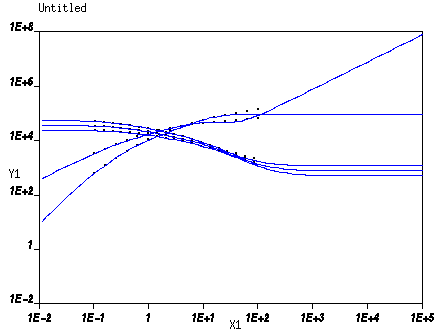Start Ansys Polymat by typing polymat. Then follow the
procedure below to perform the fitting for the data presented in Experimental Data.
Note that the fitting calculation for this example will take longer than for the generalized Newtonian example in Example 1: Non-Isothermal Generalized Newtonian Model, due to the added complexity of the model.
![]() Select Fluid Model
Select Fluid Model
Choose an Integral non-isothermal viscoelastic model.
 Integral non-isothermal viscoelastic model
Integral non-isothermal viscoelastic model
Return to the top-level menu.
![]() Material Data
Material Data
Enter the Integral Viscoelastic models menu.
 Integral Viscoelastic models
Integral Viscoelastic models
Specify the temperature dependence.
 Temperature dependence
Temperature dependence
Select the Arrhenius approximate law.
 Arrhenius approximate law
Arrhenius approximate law
Return to the Integral Viscoelastic models menu.
Specify the number of relaxation modes.
 Modify the spectrum
Modify the spectrum
Set the number of relaxation modes to
4. Number of relaxation modes
Number of relaxation modes
Return to the Integral Viscoelastic models menu.
 No modification
No modification
Specify the damping function.
 Modify the damping function
Modify the damping function
Select the Reversible Papanastasiou-Scriven model.
 Reversible Papanastasiou-Scriven model
Reversible Papanastasiou-Scriven model
Select the Modify alfa and Modify beta menu items, and keep the default values for each. (This step is necessary so that Ansys Polymat will not remind you that you need to set or confirm those values by selecting the menu items.)
Return to the Integral Viscoelastic models menu.
Return to the top-level Ansys Polymat menu.
Enter the Automatic Fitting menu.
 Automatic fitting
Automatic fitting
Enter the List of Experimental Curves menu.
 Add experimental curves
Add experimental curves
Add the first experimental curve (
visco_200.crv). Add a new curve
Add a new curve
Select the curve named visco_200.crv.
 Enter the name of the curve file
Enter the name of the curve file
Set the reference temperature to
200. Modify the temperature
Modify the temperature
Specify that the curve is a shear viscosity curve.
 Modify the curve type
Modify the curve type
Choose steady shear viscosity (the default).
 steady shear viscosity
steady shear viscosity
Return to the List of Experimental Curves menu.
Add the second experimental curve (
visco_220.crv). Add a new curve
Add a new curve
Select the curve named visco_220.crv.
 Enter the name of the curve file
Enter the name of the curve file
Set the reference temperature to
220. Modify the temperature
Modify the temperature
Specify that the curve is a shear viscosity curve.
 Modify the curve type
Modify the curve type
Choose steady shear viscosity (the default).
 steady shear viscosity
steady shear viscosity
Return to the List of Experimental Curves menu.
Repeat to add the third shear viscosity curve (
visco_240.crv) and set the appropriate reference temperature and curve type.Add the storage modulus curve (
gprime.crv). Add a new curve
Add a new curve
Select the curve named gprime.crv.
 Enter the name of the curve file
Enter the name of the curve file
Set the reference temperature to
220. Modify the temperature
Modify the temperature
Specify that the curve is a storage modulus curve.
 Modify the curve type
Modify the curve type
Choose storage modulus G’.
 storage modulus G’
storage modulus G’
Return to the List of Experimental Curves menu.
Add the loss modulus curve (
gsecond.crv). Add a new curve
Add a new curve
Select the curve named gsecond.crv.
 Enter the name of the curve file
Enter the name of the curve file
Set the reference temperature to
220. Modify the temperature
Modify the temperature
Specify that the curve is a loss modulus curve.
 Modify the curve type
Modify the curve type
Choose loss modulus G".
 loss modulus G"
loss modulus G"
Return to the List of Experimental Curves menu.
Return to the Automatic Fitting menu.
Plot the five experimental data curves.
 Draw experimental curves
Draw experimental curves
Set the numerical parameters for the calculation.
 Numerical options for fitting
Numerical options for fitting
Limit the range of relaxation times to be from a minimum of
0.1to a maximum of10. Modify the range of relaxation times
Modify the range of relaxation times
Return to the Automatic Fitting menu.
Specify a name for the material data file (for example,
example3.mat). Enter the name of the result file
Enter the name of the result file
Start the fitting calculation.
 Run fitting
Run fitting
The results of the fitting calculation are as follows:
RESULTS Integral Viscoelastic models Integral viscoelastic flow Type of model : KBKZ model N2 / N1 = 0.0000000E+00 [auto] ad.visc. = 0.7632522E+03 [auto] Damping function : Reversible Papanastasiou - Scriven alfa = 0.6365238E+01 [auto] beta = 0.0000000E+00 [auto] Number of relaxation modes = 4 Mode - Viscosity - Relaxation Time 1 6.63042E+03 [auto] 1.00000E-01 [auto] 2 7.89786E+03 [auto] 4.64159E-01 [auto] 3 1.51692E+04 [auto] 2.15443E+00 [auto] 4 4.68693E+03 [auto] 1.00000E+01 [auto] Arrhenius approximate law h(t) = exp( -alfa * (t - talfa) ) alfa = 0.2150435E-01 [auto] talfa = 0.2200000E+03 [auto]
The computed and experimental curves are shown in Figure 10.3: Plot of Computed and Experimental Curves.



